It’s been ingrained into our minds and angling modus operandi that when fishing trout in Michigan we should either fish dry flies dead drift to match-a-hatch, or cast a big streamer to entice either a big eater or territorial fish. And if those don’t work, maybe – just maybe – some might even try nymphing. Long forgotten is fishing wet flies – probably one of the oldest presentations and, at times, most effective in certain circumstances.
When:
Let’s face it – there are fewer times when the stars align and a hatch occurs while fish are looking up. If you aren’t prepared to fish a streamer, or even want to, then this approach is ideal and a fun way to fish. It’s also a way to score a fish when it seems the river might not give up much.
Can’t figure how to match the hatch? I learned the true value of swinging soft hackle flies a few years ago in Idaho. Four fishing guides were equipped with a number of over-stuffed fly boxes and keen eyes, but we couldn’t figure out what the fish were eating. Frustration set in, and the conversation turned to topics other than fishing when Andy refocused and suggested I try a soft hackle pattern. Problem solved, code cracked, and fly rod bent with a number of trout playing the game over the next hour.
What:
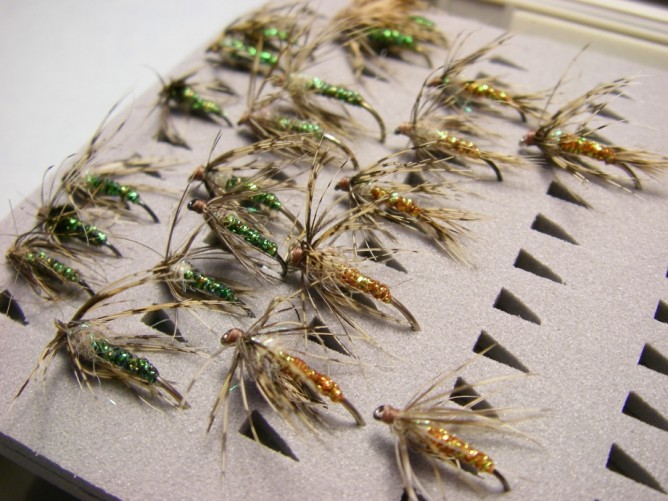 A soft hackle fly is a type of wet fly – it is not a nymph, streamer or dry. The idea is to present a pattern that looks like an aquatic insect below the surface – perhaps a diving caddis, a spent mayfly spinner, a mayfly emerger or even an attractor – which the fish can better see under the surface. The soft hackle typically has a longer, spidery-like construction that when fished under the surface and across the river, moves and undulates, looking like natural food.
A soft hackle fly is a type of wet fly – it is not a nymph, streamer or dry. The idea is to present a pattern that looks like an aquatic insect below the surface – perhaps a diving caddis, a spent mayfly spinner, a mayfly emerger or even an attractor – which the fish can better see under the surface. The soft hackle typically has a longer, spidery-like construction that when fished under the surface and across the river, moves and undulates, looking like natural food.
Have you ever let your dry fly straighten out downstream below you and swing back and forth below the surface as you talked with a friend, looked at some wildlife or fumbled through your vest, only to have a fish eat? That is essentially swinging a wet fly. In those situations we often laugh that the only way to catch fish is by not trying, but think about it – your fly at that moment is presented in a specific way and it conjured up a strike. Why not focus on presenting a fly in that manner?
Where:
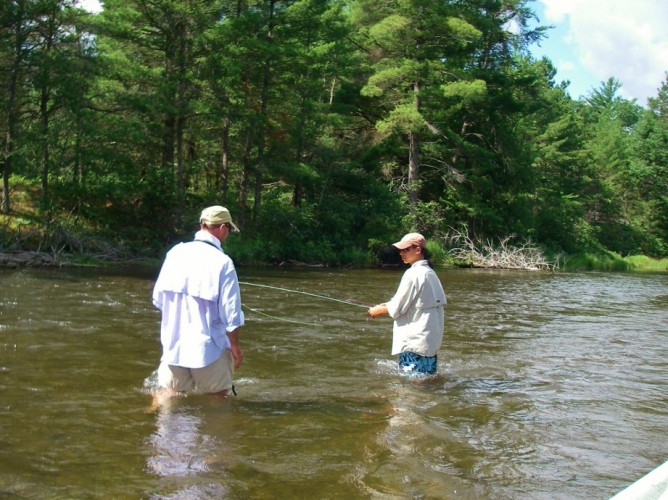 This method needs the current to help swing the fly across likely holding water. Riffle sections are ideal, especially when a caddis hatch has either occurred recently or is occurring. Fishing above likely fish- holding water, or even where you know fish are, is ideal.
This method needs the current to help swing the fly across likely holding water. Riffle sections are ideal, especially when a caddis hatch has either occurred recently or is occurring. Fishing above likely fish- holding water, or even where you know fish are, is ideal.
Ever witness fish barely breaking the surface or even just “bulging” the water upward? That is indicative of a fish focused on eating emergers; swinging a soft hackle when you don’t have an emerger pattern can be the ticket.
How:
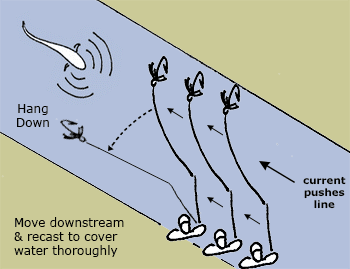 One of the reasons this presentation often works so well is because when done right, it covers the water very systematically and thoroughly. In a typical situation, the angler casts at about 45 degrees downstream. A powerful stop of the rod, keeping your rod tip high, will ensure that the line, leader and ultimately the fly will straighten. If fishing where the current is uniform, the water pushes the line, swinging the fly downstream and across the river. Lower your tip and track the fly as it swims across the river.
One of the reasons this presentation often works so well is because when done right, it covers the water very systematically and thoroughly. In a typical situation, the angler casts at about 45 degrees downstream. A powerful stop of the rod, keeping your rod tip high, will ensure that the line, leader and ultimately the fly will straighten. If fishing where the current is uniform, the water pushes the line, swinging the fly downstream and across the river. Lower your tip and track the fly as it swims across the river.
When your line has straightened out downstream – known as the “Hang Down” – don’t be so eager to recast. Let the water weave, bob and undulate the fly in the current for a few seconds. Often fish will follow the fly around and eat it at this point. Try lifting your rod tip up and down or even taking a few short strips upstream to entice some action – this is basically the presentation of Tenkara fishing – presenting a pattern straight down stream.
After a cast or two, take a step or move the boat downstream to make sure the water is being fished by your presentation. When fishing an expansive riffle, the strike can come anywhere, but if fishing mixed water with varying structure (submerged logs, a large rock, deeper run, hole, etc.) you will want to make sure you fish it effectively and controlled.
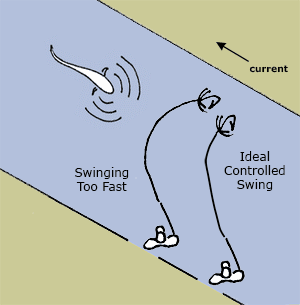 When multiple current speeds and seams make up the run, we may need to mend the line to control the speed of the fly and make sure the fly is downstream of the leader and line. If the fly moves significantly fast, it appears unnatural and might seem to the fish like too much work to chase. Rather than add additional line to the mend, we more or less want to steer the line by placing it either upstream or downstream depending on the situation to slow or speed the swing.
When multiple current speeds and seams make up the run, we may need to mend the line to control the speed of the fly and make sure the fly is downstream of the leader and line. If the fly moves significantly fast, it appears unnatural and might seem to the fish like too much work to chase. Rather than add additional line to the mend, we more or less want to steer the line by placing it either upstream or downstream depending on the situation to slow or speed the swing.
Because we are fishing a “tight” line – that is with virtually no slack in it – there is no mistaking when a fish takes. The jolt is part of the fun, but it can be frustrating if you don’t expect it and react with a heavy hook set, pulling the fly from the fish or even launching smaller fish skyward. Instead, anticipate the strike and raise the rod tip smoothly when you feel the bite- it’s as easy as that, but difficult to do at the same time.
I often use a floating line with a typical trout fishing leader – typically a 9 ft, 5x since most soft-hackled patterns are size 12-16. If fishing fast and/or deep water, sometimes a sinking leader can be used to bring that fly just a little deeper in the water column – still with a 5x tippet. Rod size is your preference – typically longer 8’6″ or 9 ft. rods are better because they allow you to control the presentation better, but if fishing smaller water, a shorter rod works, too.
Swinging for Steelhead
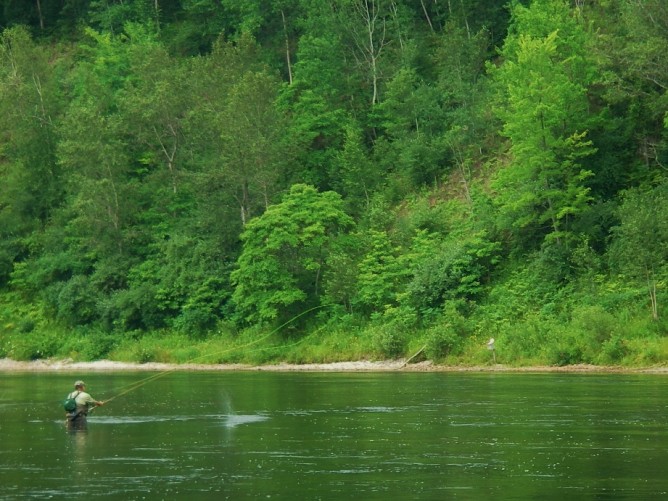 Ever think about learning how to swing flies for steelhead, possibly using a two-handed or spey rod?
Ever think about learning how to swing flies for steelhead, possibly using a two-handed or spey rod?
Well, this essentially is the same concept and approach – presenting a fly, sub-surface, through likely fish-holding water and doing so controlled in regards to speed and leading with the fly. In fact, learning how to fish for trout by swinging soft hackles will help you improve your technique when going after steelhead with intentions of swinging a fly.
More on fishing Soft Hackles and Wet Fly fishing:
Common Patterns:
Partridge and Orange, Partridge and Yellow, March Brown, Partridge and Peacock, Pheasant Tail, Crackleback, Galloup’s Rusty Sunk Spinner
Books:
“Wet Flies: Tying and Fishing Soft-Hackles, Winged and Wingless Wets, and Fuzzy Nymphs” By Dave Hughes
“The Soft-Hackled Fly” and “The Soft Hackled Fly Addict” by Sylvester Nemes
On-line article: “The Soft Hackle Wet Fly – Back to Basics” By Jack Gartside
“When Nothing’s Rising” By John Gierach
soft hackled flies, swinging soft hackles, trout, trout in michigan, wet fly fishing











































